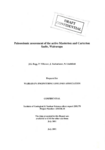Paleoseismic assessment of the active Masterton and Carterton faults, Wairarapa
Search in document library
Purpose of the Report
To investigate the timing and characteristics of past earthquakes on the Masterton and Carterton faults to better understand seismic hazard in the Wairarapa region.
Geographic Area Covered
The report focuses on the Masterton and Carterton faults located in the Wairarapa region of New Zealand, near the towns of Masterton and Carterton.
Summary of Key Findings
This report presents findings from trenching investigations on the Masterton and Carterton faults, two active faults in the Wairarapa region. These faults are capable of generating moderate to large earthquakes and are located close to the urban centres of Masterton and Carterton. The study involved excavating trenches to examine fault structures and collect data on past earthquake events. At the Masterton Fault site near Renall’s timber yard, trenching revealed two steeply south-dipping fault planes cutting through gravel and loess layers. Evidence suggests at least one surface rupture event occurred in the Holocene, possibly more, but the absence of younger sediments limited the ability to identify individual events. At the Carterton Fault site near Cobden Road, trenching exposed faulted Holocene sediments including gravels, sands, and swamp deposits. Radiocarbon dating of organic material in these layers indicates at least two surface rupture events occurred in the last 10,000 years, with one event between approximately 2,700 and 340 years ago. The Carterton Fault shows both strike-slip and normal faulting characteristics, with estimated slip rates of around 2 mm/year and single event displacements of up to 2 metres. This suggests a recurrence interval of roughly 1,000 years for significant earthquakes. The Masterton Fault also shows normal faulting and is estimated to have a recurrence interval of around 1,000 years, though data is less certain. The report recommends further trenching and dating of geological surfaces to better constrain fault activity and improve hazard assessments. Understanding these faults is important for planning and risk mitigation in the Wairarapa region.
